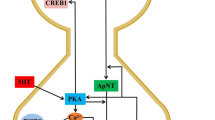Abstract
The identification of local detectors, command neurons, and modulator neurons has opened up the possibility of the structural identification of individual synaptic contacts supporting the functioning of the reflex arc. Nonassociative plasticity (habituation and sensitization) are [sic] realized at the level of the receptors and potential-dependent calcium channels through dephosphorylation-phosphorylation of receptor and channel proteins. Associative plasticity (the development and extinction of the conditioned reflex) includes two leles of regulation: short-term (through dephosphorylation-phosphorylation of receptor and channel proteins) and long-term (through the expression of genes coding structural and translocational genes). Its selectivity is an extremely important characteristic of associative plasticity. The mechanism of associative plasticity is based on the principles of the Hebb plastic synapse, supplemented by indication of the role of nonspecific (modulating) influences.
Similar content being viewed by others
References
G. G. Arakelov and T. A. Palikhova, “The central mechanisms of the organization of movements,” in:A Neurocybernetic Analysis of the Mechanisms of Behavior [in Russian], Nauka, Moscow (1985), pp. 84–101.
G. G. Arakelov, I. V. Marakueva, and T. A. Palikhova, “Monosynaptic connection: identifiable synapses in the CNS of the snail,”Zh. Vyssh. Nerv. Deyat.,39, No. 4, 737–745 (1989).
P. M. Balaban, I. S. Maksimova, “The neuronal organization of reflexes,” in:A Neurocybernetic Analysis of the Mechanisms of Behavior [in Russian], Nauka, Moscow (1985), pp. 29–45.
P. M. Balaban, N. I. Bravarenko, and I. S. Zakharov, “The neurochemical basis of backward inhibition in the reflex arc of the defense reaction,”Zh. Vyssh. Nerv. Deyat.,41, No. 5, 1033–1038 (1991).
N. I. Bravarenko, P. M. Balaban, and E. N. Sokolov, “The organization of the sensory input of the system of command neurons,”Zh. Vyssh. Nerv. Deyat.,32, No. 1, 94–99 (1982).
T. N. Grechenko, “The plasticity of the isolated command neuron,” in:A Neurocybernetic Analysis of the Mechanisms of Behavior [in Russian], Nauka, Moscow (1985), pp. 149–162.
T. N. Grechenko and L. K. Khludova, “A neurophysiological analysis of the pattern of response to direct electrical stimulation of the LPa3 and RPa3 neurons of the snail,”Zh. Vyssh. Nerv. Deyat.,40, No. 3, 597–599 (1990).
T. L. Dyakonova, “The neurochemical mechanisms of regulation of burst activity in isolated endogenous oscillators of the snail: the role of monoamines and opioid peptides,”Neirofiziologiya,23, No. 4, 472–480 (1991).
I. S. Zakharov and P. M. Balaban, “The participation of modulatory neurons in the organization of the defense behavior of the snail,” in:The Integrative Activity of the Neuron: Molecular Bases. Summaries of Reports of International Symposium [in Russian], Moscow (1988), p. 51.
T. G. Zubova, A. L. Krylova, and E. N. Sokolov, “The pacemaker plasticity of the command neuron of the defense reflex of the snail,”Zh. Vyssh. Nervn. Deyat.,31, No. 6, 1263–1269 (1981).
T. G. Zubova, “The plasticity of the pacemaker mechanism of the command neuron,” in:A Neurocybernetic Analysis of the Mechanisms of Behavior [in Russian], Nauka, Moscow (1985), pp. 130–141.
N. I. Kononenko and O. N. Osipenko, “The monosynaptic pathway responsible for the generation of burst activity in the RPal neuron of the snail,”Neirofiziologiya,19, No. 1, 20–28 (1987).
A. L. Krylova, “The plasticity of the neuron,” in:The Pacemaker Potential of the Neuron [in Russian], Metsniereba, Tbilisi (1975), pp. 87–108.
A. L. Krylova,Endoneuronal Habituation [in Russian], In-t VND i NF, Moscow (1977).
E. Kandel,The Cellular Mechanisms of Behavior [Russian translation], Mir, Moscow (1980).
O. A. Maksimova and P. M. Balaban,The Neuronal Mechanisms of the Plasticity of Behavior [in Russian], Nauka, Moscow (1983).
O. A. Maksimova and P. M. Balaban, “Associative learning at the level of the command neurons,” in:A Neurocybernetic Analysis of the Mechanisms of Behavior [in Russian], Nauka, Moscow (1985), pp. 141–149.
T. A. Palikhova and G. G. Arakelov, “The monosynaptic connections in the central nervous system of the snail: receptive fields of presynaptic neurons,”Zh. Vyssh. Nervn. Deyat.,40, No. 6, 1186–1189 (1990).
T. A. Palikhova, I. V. Marakueva, and G. G. Arakelov, “The mono- and polysynaptic connections between identified neurons in the arc of the passive defense reflex of the snail,”Zh. Vyssh. Nervn. Deyat.,42, No. 6, 1170–1179 (1992).
A. S. Pivovarov, “The cholinoreceptors of neurons of the snail: identification, plasticity, and its regulation by opioids and second messengers,”Zh. Vyssh. Nervn. Deyat.,42, No. 6 (1992).
E. N. Sokolov and D. V. Logunov, “The identified synapse: physiological preconditions and the system of identification,”Dokl. Akad. Nauk SSSR,282, No. 5, 1508–1512 (1985).
E. N. Sokolov and G. G. Baitkyavichus,The Neurointellect: From Neuron to Neurocomputer [in Russian], Nauka, Moscow (1988).
L. K. Khludova and E. N. Sokolov, “Ion channels in the electrical sensitivity of neurons,”Vestn. Mosk. Gos. Univ. Ser. Psikhologiya, No. 2, 14–19 (1983).
E. D. Shekhter and G. G. Arakelov, “The receptive field of the command neuron,” in:A Neurocybernetic Analysis of the Mechanisms of Behavior [in Russian], Nauka, Moscow (1985). pp. 64–84.
E. D. Shekhter, “The mechanosensitive receptive field of the identified neuron of the mollusc,”Zh. Vyssh. Nervn. Deyat.,30, No. 5, 1079–1082 (1980).
E. D. Shkhter, G. G. Arakelov, and E. N. Sokolov, “The plasticity of the receptive field of the polyfunctional neuron,”Zh. Vyssh. Nervn. Deyat.,32, No. 3, 440–446 (1982).
E. D. Shekhter, “The sensitivty of the LPa3 command neuron to electrical stimulation of its receptive field,” in:Simple Nervous Systems [in Russian], Nauka, Leningrad (1988), pp. 324–327.
P. M. Balaban, “Postsynaptic mechanisms of withdrawal reflex sensitization in the snail,”Neurobiology,14, No. 5, 365–375 (1983).
W. Singer, “Activity-dependent self-organization of synaptic connections a substrate of learning,” in:Neural and Molecular Learning, J.-P. Changeux and M. Konisni (eds.), John Wiley and Sons, Chichester-New York-Brisbane-Toronto-Singapore (1987), pp. 301–335.
I. S. Zakharov and P. M. Balaban, “Serotoninergic modulation of avoidance behavior inHelix,” in:Studies in Neuroscience. No. 13. Simpler Nervous Systems, D. A. Sakharov and W. Winlow (eds.), Manchester University Press, Manchester-New York (1991), pp. 316–329.
Author information
Authors and Affiliations
Additional information
Translated from Zhurnal Vysshei Nervnoi Deyatel'nosti imeni I. P. Pavlova, Vol. 42, No. 6, pp. 1064–1074, November–December, 1992.
Rights and permissions
About this article
Cite this article
Sokolov, E.N. The architecture of the reflex arc. Neurosci Behav Physiol 24, 5–11 (1994). https://doi.org/10.1007/BF02355647
Received:
Revised:
Issue Date:
DOI: https://doi.org/10.1007/BF02355647




